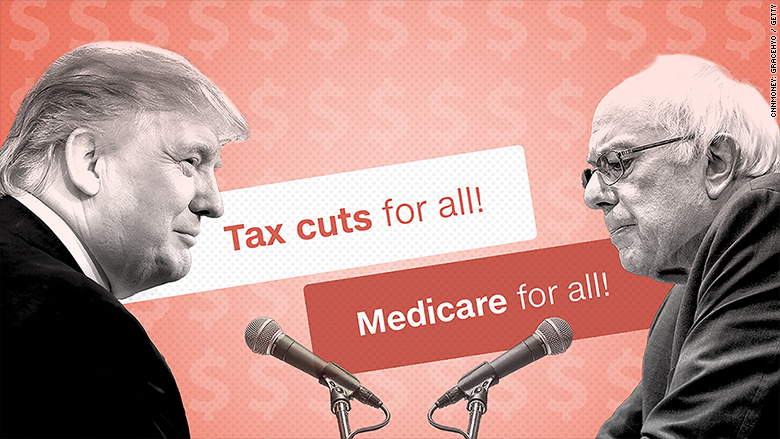
When you make a sweeping proposal costing many trillions of dollars, you really should make clear how you plan to pay for it beyond vague promises.
Bernie Sanders finally did just that this weekend by detailing the many tax increases he would impose to pay for his Medicare for All plan. That plan is estimated by his campaign to cost nearly $14 trillion over a decade.
But Republican frontrunner Donald Trump, who has essentially proposed a Tax Cuts for All plan, has yet to offer a detailed explanation of how his plan -- one of the costliest tax proposals this season -- would pay for itself.
Trump has repeatedly asserted that his tax plan will not add to the country's debt. But outside analyses beg to differ.
The Tax Policy Center, for instance, estimates that his plan would drain federal coffers of more than $10 trillion over the next decade, and another $15 trillion in the subsequent decade.
That's after accounting for the few specific measures Trump offers as stated "pay-fors" -- such as requiring U.S. companies to pay a one-time discounted tax on existing overseas profits and no longer letting them postpone their U.S. tax payments on future income earned abroad.
The Trump campaign has not answered the Tax Policy Center's questions nor responded to requests for comment from CNNMoney.
Economic growth to the rescue?
Trump appears to lean heavily on economic growth to pay for his plan.
"The economy's going to just be absolutely like a rocket," he told CNN last fall.
His campaign manager said in a separate CNN interview that if the economy grows at 3% the plan would pay for itself. Any further growth, the manager added, would reduce deficits.
Here's why the Tax Policy Center finds that assertion highly implausible:
Under its analysis, Trump's plan would reduce revenue by $1 trillion a year on average from current levels. That's assuming a 2.1% growth rate.
Related: Donald Trump's big tax cuts come at a big cost
The revenue loss would be less if growth were actually 3%, as the Trump campaign assumes, but not that much less. An additional percentage point of growth might yield $50 billion in revenue, said Joe Rosenberg, a coauthor of the Tax Policy Center report.
That still leaves a $950 billion hole.
Even if the economy grew 10% -- the stuff of fiscal fantasy, no matter how awesome one's tax plan -- it might raise an additional $400 billion, still not enough to pay for the estimated annual revenue loss.
Okay, so what about spending cuts?
Trump's tax plan doesn't specifically assert that spending cuts would pay for his tax proposals.
But he often publicly laments the nearly $19 trillion in federal debt the country has already accumulated, promising to attack it with spending cuts.
"We're going to be cutting tremendous amounts of money ... lots of waste and fraud and abuse. I'm not cutting services. I may cut the Department of Education ... Environmental protection, what they do is a disgrace," Trump has said.
He also favors defunding Planned Parenthood.
If Trump's goal is to reduce deficits, those items amount to fiscal crumbs.
Less than 3% of the $3.7 trillion the government spent in the last year went to the EPA ($7 billion), the Department of Education ($90 billion) and Planned Parenthood ($450 million) combined.
As for waste, fraud and abuse? They may be inexcusable, but you can never eliminate them completely and what you can eliminate won't make a real dent in the debt, according to the Committee for a Responsible Federal Budget.
The one area that might -- entitlement spending -- is something Trump has said he won't touch.
Instead he wants to recapture money from other areas of the economy to, say, shore-up Social Security's long-term funding shortfall.
How exactly? Vaguely.
"I'm going to stop losing $400 billion with China when they take our jobs and everything else. I'm going to stop losing $70 billion a year with Japan ... and we're going to do absolutely fine," he has said.
Digging a deep hole deeper
So far, Trump hasn't offered plausible proposals to stop today's debt from growing. And absent enormous spending cuts or other extreme changes, his tax plan could make it far worse.
The debt today is worth roughly 75% of GDP. Under Trump's plan alone, it could jump to 120% of GDP in a decade, according to CRFB. (Send feedback to cnnmoneyeditors@turner.com.)


